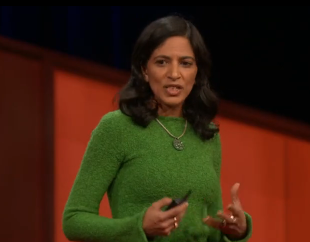So for example, spontaneous synchronization,
例如自发同步现象,
how audiences are clapping and suddenly start all clapping together, the fireflies flashing together.
观众是怎样鼓掌,怎样突然一起开始鼓掌的,萤火虫如何同步闪烁。
We can program rules for pattern formation,
我们可以编码图案形成的规则,
how cells in a tissue determine what role they're going to take on and set the patterns of our bodies.
组织中的细胞如何决定它们将会起什么样的作用,进而决定我们的人体结构的。
We can program rules for migration, and in this way, we're really learning from nature's rules.
我们可以编码迁移的规则,这样一来我们真的是在借鉴自然法则。
But we can also take it a step further.
但我们也可以更进一步。
We can actually take these rules that we've learned from nature and combine them and create entirely new collective behaviors of our very own.
我们可以将这些从自然中学到的规律结合在一起,创造全新的、属于我们自己的集体行为。

So for example, imagine that you had two different kinds of rules.
例如,想象一下你有两种不同的规则。
So your first rule is a motion rule where a moving robot can move around other stationary robots.
第一种是运动规则,运动的机器人可以在其他固定的机器人周围移动。
And your second rule is a pattern rule where a robot takes on a color based on its two nearest neighbors.
第二种是样式规则,机器人参考相邻的两个机器人,呈现与其不同的颜色。
So if I start with a blob of robots in a little pattern seed,
如果从一小组机器人开始,
it turns out that these two rules are sufficient for the group to be able to self-assemble a simple line pattern.
结果显示这两种规则已经足够实现让群体自我组装成一个简单的线性图案这一目标。
And if I have more complicated pattern rules, and I design error correction rules,
如果我用更复杂的样式规则,并且设计错误更正规则,
we can actually create really, really complicated self assemblies, and here's what that looks like.
我们就可以创造非常复杂的自组装结构了,给大家展示一下初步成果。











